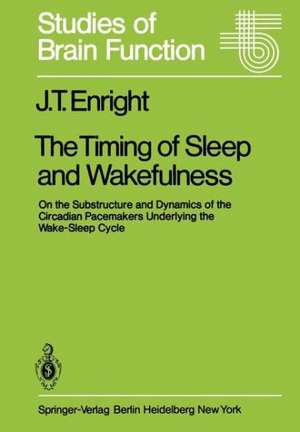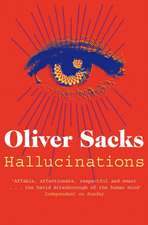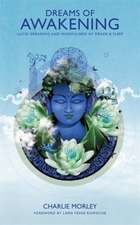The Timing of Sleep and Wakefulness: On the Substructure and Dynamics of the Circadian Pacemakers Underlying the Wake-Sleep Cycle: Studies of Brain Function, cartea 3
Autor J. T. Enrighten Limba Engleză Paperback – feb 1980
Din seria Studies of Brain Function
- 15%
 Preț: 631.72 lei
Preț: 631.72 lei - 15%
 Preț: 636.45 lei
Preț: 636.45 lei - 15%
 Preț: 647.73 lei
Preț: 647.73 lei - 15%
 Preț: 584.58 lei
Preț: 584.58 lei -
 Preț: 383.33 lei
Preț: 383.33 lei - 18%
 Preț: 784.13 lei
Preț: 784.13 lei -
 Preț: 394.51 lei
Preț: 394.51 lei - 15%
 Preț: 641.71 lei
Preț: 641.71 lei - 15%
 Preț: 640.06 lei
Preț: 640.06 lei - 15%
 Preț: 641.71 lei
Preț: 641.71 lei - 15%
 Preț: 639.41 lei
Preț: 639.41 lei - 18%
 Preț: 721.63 lei
Preț: 721.63 lei - 15%
 Preț: 640.24 lei
Preț: 640.24 lei - 15%
 Preț: 632.37 lei
Preț: 632.37 lei - 15%
 Preț: 638.24 lei
Preț: 638.24 lei - 15%
 Preț: 639.41 lei
Preț: 639.41 lei
Preț: 642.03 lei
Preț vechi: 755.33 lei
-15% Nou
Puncte Express: 963
Preț estimativ în valută:
122.87€ • 127.80$ • 101.43£
122.87€ • 127.80$ • 101.43£
Carte tipărită la comandă
Livrare economică 14-28 aprilie
Preluare comenzi: 021 569.72.76
Specificații
ISBN-13: 9783540096672
ISBN-10: 3540096671
Pagini: 288
Ilustrații: XVIII, 263 p.
Dimensiuni: 170 x 244 x 15 mm
Greutate: 0.46 kg
Ediția:Softcover reprint of the original 1st ed. 1980
Editura: Springer Berlin, Heidelberg
Colecția Springer
Seria Studies of Brain Function
Locul publicării:Berlin, Heidelberg, Germany
ISBN-10: 3540096671
Pagini: 288
Ilustrații: XVIII, 263 p.
Dimensiuni: 170 x 244 x 15 mm
Greutate: 0.46 kg
Ediția:Softcover reprint of the original 1st ed. 1980
Editura: Springer Berlin, Heidelberg
Colecția Springer
Seria Studies of Brain Function
Locul publicării:Berlin, Heidelberg, Germany
Public țintă
ResearchCuprins
1 Introduction.- 2 A Description of Activity-rhythm Recordings and Their Implications.- 3 The Pacemaker and its Precision.- 4 A Class of Models for Mutual Entrainment of an Ensemble of Neurons.- 4.1 Structure and Dynamics of the Coupling.- 4.2 Intermittent Feedback.- 4.3 Discussion of the Coupling.- Appendix 4.A. Calculations Based on Conditional Probability.- Appendix 4.B. A FORTRAN Program for Computer Simulation.- 5 A “Type Model” and its Behavior: Partial and Loose-Knit Mutual Entrainment.- Appendix 5.A. Relative Coordination of Unentrained Pacers.- 6 Precision of Model Pacemakers.- 6.1 Precision, as Affected by Number of Pacers.- 6.2 Influence of Alpha and Beta on Precision.- 6.3 Precision as Affected by ?, x?b and ?.- 6.4 Threshold of the Discriminator.- 6.5 The Implications of Experimentally Observed Precision.- 6.6 Alternative Formulations of Parameters.- 6.7 The Relationship Between Pacer Input and Discriminator Output.- 6.8 Stochastic Variation in Threshold.- 6.9 Summary of Factors Influencing Precision.- Appendix 6.A. On the Influence of N upon Precision (by J. Thorson).- 7 Influences of Constant Light Intensity.- 7.1 Effects of Light upon Free-running Period.- 7.2 Effects of Light upon Duration and Intensity of Activity.- 7.3 Effects of Light Intensity upon Precision.- 7.4 Extremes of Constant Lighting Conditions.- 7.5 Ranges of Free-running Period Values.- 7.6 Summary.- Appendix 7.A. Aschoff’s Rule: Models with Other Parameter Values.- 8 A Brief Detour: Further Thoughts About the Discriminator of the Models.- 8.1 The Magnitude of Feedback.- 8.2 Stochastic Variation in Amount of Feedback.- 8.3 Can the Discriminator be Eliminated?.- 8.4 Threshold and Feedback: an Extreme Case.- 8.5 Inhibition vs Excitation.- Appendix 8.A. Pacemaker Ensembles with aThreshold of One: A Revolving Dictatorship.- 9 General Features of Entrainment: the Type Model.- 9.1 Entrainment of Nocturnal Animals: Inhibition by Light.- 9.2 Phasic vs Tonic Effects of Light.- 9.3 Entrainment of Diurnal Animals: Stimulation by Light.- 9.4 The “Anomalous” Effects of Threshold on Pacemaker Period.- 9.5 Entrainment with Gradual Transitions in Light Intensity.- 10 Responses to Single Light Pulses. Part I: Nocturnal Rodents.- 10.1 Phase Shifts of Coupled Stochastic Systems.- 10.2 Transients During Phase Advance: Their Origin and Significance.- 10.3 Interspecies Variations in Phase-response Curves.- 10.4 A Failure of the Elementary Class of Models.- Appendix 10.A. Transients Following Phase Shifts.- 11 Responses to Single Light Pulses. Part II: Diurnal Birds.- 11.1 Simulation Results: Several Deficiencies and Their Remedy.- 11.2 Phase-response Curves: a Review.- Appendix 11.A Constraints on Parameter Values.- 12 Plasticity in Pacemaker Period: a Dynamic Memory.- 12.1 After-effects of Initial Phase Conditions.- 12.2 After-effects of Entrainment.- 12.3 After-effects of Constant Light Intensity.- 12.4 After-effects of Phase Shifting and of Photo-period.- 12.5 Permanent vs Transitory Differences in Period.- 12.6 Bistability of a Pacemaker.- Appendix 12.A After-effects of Phase Shifting and of Photoperiod.- 12.A.1 Single Shifts of Phase.- 12.A.2 After-effects of Photoperiod.- Appendix 12.B Alternative Steady States in a Coupled Stochastic System.- 13 Predictions from Coupled Stochastic Systems.- 13.1 Introduction.- 13.2 Predictions Related to Aschoff’s Rule.- 13.3 Predictions Relating to Entrainment by Sinusoidal Light Cycles.- 13.4 Predictions About “Phasic” Effects of Light.- 13.5 Predictions About Transients.- 13.6 Predictions AboutAfter-effects.- 13.7 Predictions About Phase Shifting by “Dark Pulses”.- 13.8 Quantitative Predictions.- 14 Further Predictions: a Modest Success and Two Problem Cases.- 14.1 “Clamped” Free-run Experiments.- 14.2 Two Problem Cases.- Appendix 14.A Reconciling Phase Advance with Aftereffects.- 15 Morphology of the Models: Where is the Pacemaker?.- 15.1 The Pacers.- 15.2 The Discriminator.- 15.3 The Translation of Formalism into Concrete Morphology.- 16 A Reprise and Synopsis: On the Advantages of Apparent Redundancy.- References.- Author Index.














